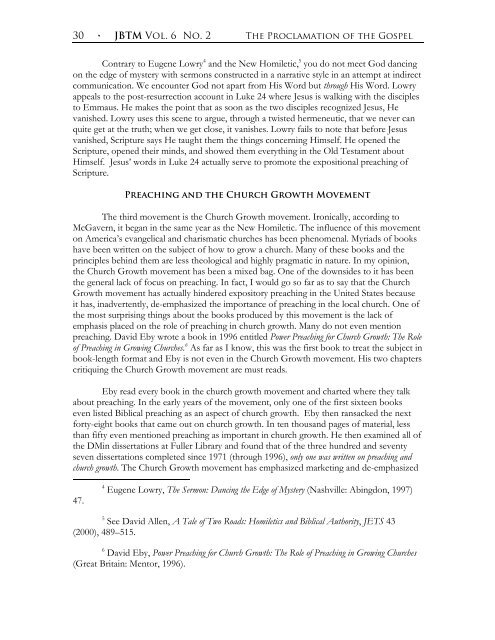0 jbtm vol. 6, no. 2 the proclamation of the gospel - Baptist Center for ...
0 jbtm vol. 6, no. 2 the proclamation of the gospel - Baptist Center for ...
0 jbtm vol. 6, no. 2 the proclamation of the gospel - Baptist Center for ...
Create successful ePaper yourself
Turn your PDF publications into a flip-book with our unique Google optimized e-Paper software.
30 ٠ JBTM Vol. 6 No. 2 The Proclamation <strong>of</strong> <strong>the</strong> Gospel<br />
Contrary to Eugene Lowry 4 and <strong>the</strong> New Homiletic, 5 you do <strong>no</strong>t meet God dancing<br />
on <strong>the</strong> edge <strong>of</strong> mystery with sermons constructed in a narrative style in an attempt at indirect<br />
communication. We encounter God <strong>no</strong>t apart from His Word but through His Word. Lowry<br />
appeals to <strong>the</strong> post-resurrection account in Luke 24 where Jesus is walking with <strong>the</strong> disciples<br />
to Emmaus. He makes <strong>the</strong> point that as soon as <strong>the</strong> two disciples recognized Jesus, He<br />
vanished. Lowry uses this scene to argue, through a twisted hermeneutic, that we never can<br />
quite get at <strong>the</strong> truth; when we get close, it vanishes. Lowry fails to <strong>no</strong>te that be<strong>for</strong>e Jesus<br />
vanished, Scripture says He taught <strong>the</strong>m <strong>the</strong> things concerning Himself. He opened <strong>the</strong><br />
Scripture, opened <strong>the</strong>ir minds, and showed <strong>the</strong>m everything in <strong>the</strong> Old Testament about<br />
Himself. Jesus’ words in Luke 24 actually serve to promote <strong>the</strong> expositional preaching <strong>of</strong><br />
Scripture.<br />
Preaching and <strong>the</strong> Church Growth Movement<br />
The third movement is <strong>the</strong> Church Growth movement. Ironically, according to<br />
McGavern, it began in <strong>the</strong> same year as <strong>the</strong> New Homiletic. The influence <strong>of</strong> this movement<br />
on America’s evangelical and charismatic churches has been phe<strong>no</strong>menal. Myriads <strong>of</strong> books<br />
have been written on <strong>the</strong> subject <strong>of</strong> how to grow a church. Many <strong>of</strong> <strong>the</strong>se books and <strong>the</strong><br />
principles behind <strong>the</strong>m are less <strong>the</strong>ological and highly pragmatic in nature. In my opinion,<br />
<strong>the</strong> Church Growth movement has been a mixed bag. One <strong>of</strong> <strong>the</strong> downsides to it has been<br />
<strong>the</strong> general lack <strong>of</strong> focus on preaching. In fact, I would go so far as to say that <strong>the</strong> Church<br />
Growth movement has actually hindered expository preaching in <strong>the</strong> United States because<br />
it has, inadvertently, de-emphasized <strong>the</strong> importance <strong>of</strong> preaching in <strong>the</strong> local church. One <strong>of</strong><br />
<strong>the</strong> most surprising things about <strong>the</strong> books produced by this movement is <strong>the</strong> lack <strong>of</strong><br />
emphasis placed on <strong>the</strong> role <strong>of</strong> preaching in church growth. Many do <strong>no</strong>t even mention<br />
preaching. David Eby wrote a book in 1996 entitled Power Preaching <strong>for</strong> Church Growth: The Role<br />
<strong>of</strong> Preaching in Growing Churches. 6 As far as I k<strong>no</strong>w, this was <strong>the</strong> first book to treat <strong>the</strong> subject in<br />
book-length <strong>for</strong>mat and Eby is <strong>no</strong>t even in <strong>the</strong> Church Growth movement. His two chapters<br />
critiquing <strong>the</strong> Church Growth movement are must reads.<br />
Eby read every book in <strong>the</strong> church growth movement and charted where <strong>the</strong>y talk<br />
about preaching. In <strong>the</strong> early years <strong>of</strong> <strong>the</strong> movement, only one <strong>of</strong> <strong>the</strong> first sixteen books<br />
even listed Biblical preaching as an aspect <strong>of</strong> church growth. Eby <strong>the</strong>n ransacked <strong>the</strong> next<br />
<strong>for</strong>ty-eight books that came out on church growth. In ten thousand pages <strong>of</strong> material, less<br />
than fifty even mentioned preaching as important in church growth. He <strong>the</strong>n examined all <strong>of</strong><br />
<strong>the</strong> DMin dissertations at Fuller Library and found that <strong>of</strong> <strong>the</strong> three hundred and seventy<br />
seven dissertations completed since 1971 (through 1996), only one was written on preaching and<br />
church growth. The Church Growth movement has emphasized marketing and de-emphasized<br />
47.<br />
4 Eugene Lowry, The Sermon: Dancing <strong>the</strong> Edge <strong>of</strong> Mystery (Nashville: Abingdon, 1997)<br />
5 See David Allen, A Tale <strong>of</strong> Two Roads: Homiletics and Biblical Authority, JETS 43<br />
(2000), 489–515.<br />
6 David Eby, Power Preaching <strong>for</strong> Church Growth: The Role <strong>of</strong> Preaching in Growing Churches<br />
(Great Britain: Mentor, 1996).


